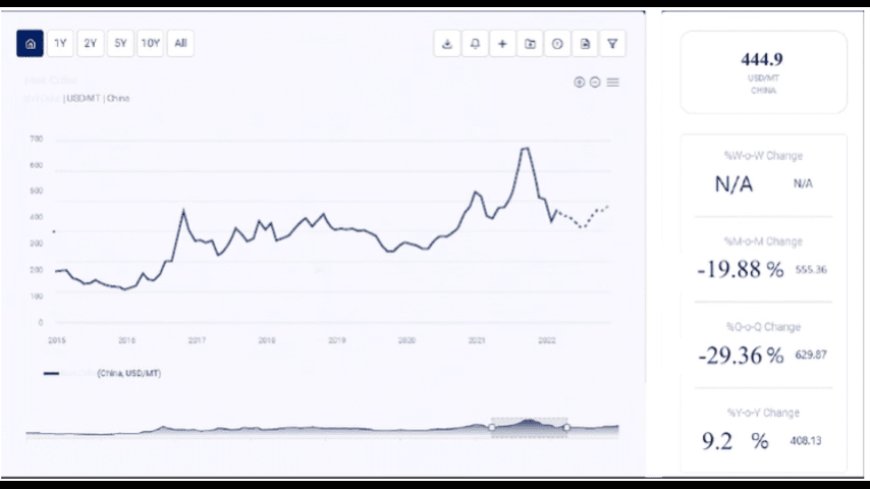Alum Price Chart: Market Dynamics and Trends Analysis
Alum, or aluminum sulfate, is an essential chemical used in various industries including water treatment, paper manufacturing, and dyeing textiles. Its price is influenced by a range of factors such as raw material costs, production methods, demand from end-use industries, and geopolitical events. Understanding the price trends of alum is crucial for manufacturers, suppliers, and industry stakeholders to make informed decisions. This article provides a detailed analysis of alum price chart, examining the factors influencing these trends, regional variations, and future market forecasts.

Alum, or aluminum sulfate, is an essential chemical used in various industries including water treatment, paper manufacturing, and dyeing textiles. Its price is influenced by a range of factors such as raw material costs, production methods, demand from end-use industries, and geopolitical events. Understanding the price trends of alum is crucial for manufacturers, suppliers, and industry stakeholders to make informed decisions. This article provides a detailed analysis of alum price chart, examining the factors influencing these trends, regional variations, and future market forecasts.
Market Overview
Alum is widely used in water purification, where it acts as a coagulating agent to remove impurities. It is also essential in the paper industry for sizing purposes, and in the textile industry for dyeing and printing. The price of alum is influenced by supply and demand dynamics, production costs, technological advancements, and regulatory policies. Major markets for alum include North America, Europe, Asia-Pacific, Latin America, and the Middle East and Africa.
Enquire For Regular Prices: https://www.procurementresource.com/resource-center/alum-price-trends/pricerequest
Current Alum Price Trends
The alum market has shown variability due to various market dynamics. Several key factors contribute to these price trends:
-
Supply and Demand Dynamics: The balance between supply and demand significantly impacts alum prices. High demand from water treatment facilities and industrial applications continues to drive prices upward. Any disruptions in supply, such as raw material shortages or production halts, can further impact prices.
-
Raw Material Costs: The cost of raw materials used in the production of alum, such as bauxite and sulfuric acid, influences production costs and, consequently, prices. Fluctuations in raw material prices due to environmental factors or market demand can lead to variability in alum prices.
-
Production Costs: The cost of producing alum, including labor, energy, and transportation, plays a crucial role in determining its market price. Advances in production technology can help reduce costs and stabilize prices.
-
Technological Advancements: Innovations in the production and processing of alum can impact supply dynamics. Technological improvements that enhance efficiency or yield can lead to changes in production costs and market prices.
-
Regulatory Policies: Regulatory changes related to the use of alum in various applications, especially in water treatment, can influence market demand and prices. Compliance with these regulations may require investments in cleaner technologies, affecting production costs and prices.
-
Geopolitical Events: Political stability in major alum-producing regions significantly affects supply chains. Geopolitical tensions or regulatory changes can lead to supply disruptions and price volatility.
Regional Price Variations
Alum prices vary across different regions due to local production capacities, demand levels, and regulatory environments. Here is a regional analysis of alum prices:
-
North America: In the US and Canada, alum prices are influenced by demand from the water treatment and paper industries. Regional factors such as economic policies, industrial activity, and local demand also play a role.
-
Europe: European alum prices are influenced by economic conditions within the Eurozone, environmental regulations, and demand from the water treatment and paper industries. Countries like Germany and the UK play significant roles in the regional market.
-
Asia-Pacific: The Asia-Pacific region, particularly China and India, is a significant market for alum due to high industrial demand. Prices in this region are driven by rapid industrialization, infrastructure projects, and technological advancements.
-
Latin America: As a growing producer of industrial chemicals, Latin America’s prices are influenced by local production, economic stability, and regional demand. Countries like Brazil and Mexico are becoming increasingly important in the global supply chain.
-
Middle East and Africa: In these regions, local demand for alum in various industries and regional economic conditions influence prices. Political stability and regulatory environments also play crucial roles.
Factors Influencing Alum Prices
Several factors play a crucial role in determining alum prices:
-
Global Economic Health: The overall health of the global economy influences investor behavior and demand for industrial chemicals like alum. Economic growth in major economies typically drives up alum prices due to increased industrial activity.
-
Supply and Demand Dynamics: The balance between alum production (supply) and consumer demand for water treatment, paper manufacturing, and other applications significantly affects prices. High demand and limited supply lead to higher prices.
-
Currency Fluctuations: Changes in currency values, particularly the US dollar, impact alum prices. A weaker dollar typically leads to higher alum prices as it becomes cheaper for foreign buyers.
-
Technological Advancements: Innovations in alum production and processing technologies can impact supply and demand dynamics. Advances that improve production efficiency or create new market opportunities can influence price trends.
-
Geopolitical Events: Events such as wars, political instability, and international conflicts can disrupt supply chains, leading to price volatility. Stability in major alum-producing regions is crucial for maintaining steady supply and prices.
-
Environmental Regulations: Environmental regulations and sustainability initiatives can impact production processes and costs. Compliance with these regulations may require investments in cleaner technologies, affecting production costs and prices.
Applications of Alum
Understanding the diverse applications of alum can provide insights into the factors driving its demand and, consequently, its price. Some of the primary applications include:
-
Water Treatment: Alum is extensively used in water treatment plants to coagulate impurities and clarify water. The demand from municipal and industrial water treatment facilities significantly drives the market.
-
Paper Manufacturing: Alum is used in the paper industry for sizing and improving paper quality. The demand from the paper manufacturing sector impacts the market dynamics.
-
Textile Industry: Alum is used in the textile industry for dyeing and printing processes. The demand from the textile industry influences the market.
-
Cosmetics and Personal Care: Alum is used as an astringent and deodorant in cosmetics and personal care products. The demand from the consumer goods sector impacts the market.
-
Construction: Alum is used in construction materials such as concrete and mortar for its binding properties. The demand from the construction industry influences the market.
-
Pharmaceuticals: Alum is used in the production of pharmaceuticals as an ingredient in vaccines and other medical formulations. The demand from the pharmaceutical industry impacts the market.
Future Price Forecast
The outlook for alum prices remains optimistic due to several factors:
-
Sustained Demand from Water Treatment and Industrial Sectors: The push for effective water treatment solutions and industrial applications is expected to keep alum demand high.
-
Economic Growth in Developing Regions: Continued industrialization and urbanization in countries like China and India will drive sustained demand for alum.
-
Supply Constraints: Potential supply constraints from major alum-producing regions due to environmental regulations or geopolitical issues could push prices higher.
-
Technological Innovations: Advances in production technology and the development of new applications for alum could drive market growth. Innovations that enhance production efficiency or create new market opportunities may help stabilize or reduce prices.
-
Global Economic Conditions: Ongoing global economic recovery efforts and infrastructure investments post-COVID-19 are likely to support higher alum prices.
-
Sustainable and Ethical Production: Increasing focus on sustainable and ethical production practices may impact alum supply and, consequently, prices. Stricter regulations and higher production costs could lead to higher prices.
Conclusion
The alum market is influenced by a complex interplay of factors, including supply and demand dynamics, economic conditions, technological advancements, and geopolitical events. The price of alum is driven by strong demand from various sectors and potential supply constraints. Investors and stakeholders should closely monitor these trends to make informed decisions and optimize their strategies.
Understanding the key factors influencing alum prices and staying abreast of market developments can help businesses navigate the dynamic landscape and achieve long-term success. As the world continues to move towards more sustainable and technologically advanced solutions, the demand for alum is expected to remain strong, supporting stable or increasing prices in the long term.
What's Your Reaction?
 Like
0
Like
0
 Dislike
0
Dislike
0
 Love
0
Love
0
 Funny
0
Funny
0
 Angry
0
Angry
0
 Sad
0
Sad
0
 Wow
0
Wow
0


















































